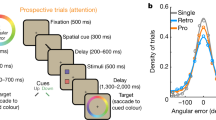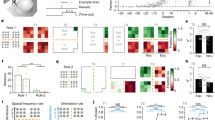Abstract
The ability to abstract principles or rules from direct experience allows behaviour to extend beyond specific circumstances to general situations. For example, we learn the ‘rules’ for restaurant dining from specific experiences and can then apply them in new restaurants. The use of such rules is thought to depend on the prefrontal cortex (PFC) because its damage often results in difficulty in following rules1. Here we explore its neural basis by recording from single neurons in the PFC of monkeys trained to use two abstract rules. They were required to indicate whether two successively presented pictures were the same or different depending on which rule was currently in effect. The monkeys performed this task with new pictures, thus showing that they had learned two general principles that could be applied to stimuli that they had not yet experienced. The most prevalent neuronal activity observed in the PFC reflected the coding of these abstract rules.
This is a preview of subscription content, access via your institution
Access options
Subscribe to this journal
Receive 51 print issues and online access
$199.00 per year
only $3.90 per issue
Buy this article
- Purchase on Springer Link
- Instant access to full article PDF
Prices may be subject to local taxes which are calculated during checkout




Similar content being viewed by others
References
Milner, B. Effects of different brain lesions on card sorting. Arch. Neurol. 9, 100–110 (1963).
Fuster, J. M. The Prefrontal Cortex: Anatomy, Physiology and Neuropsychology of the Frontal Lobe (Lippincott, Williams & Wilkins, Philadelphia, 1997).
Watanabe, M. Reward expectancy in primate prefrontal neurons. Nature 382, 629–632 (1996).
Rao, S. C., Rainer, G. & Miller, E. K. Integration of what and where in the primate prefrontal cortex. Science 276, 821–824 (1997).
Fuster, J. M., Bodner, M. & Kroger, J. K. Cross-modal and cross-temporal association in neurons of frontal cortex. Nature 405, 347–351 (2000).
Fuster, J. M. Unit activity in prefrontal cortex during delayed-response performance: neuronal correlates of transient memory. J. Neurophysiol. 36, 61–78 (1973).
di Pellegrino, G. & Wise, S. P. Visuospatial versus visuomotor activity in the premotor and prefrontal cortex of a primate. J. Neurosci. 13, 1227–1243 (1993).
Asaad, W. F., Rainer, G. & Miller, E. K. Neural activity in the primate prefrontal cortex during associative learning. Neuron 21, 1399–1407 (1998).
Goldman-Rakic, P. C. Cellular basis of working memory. Neuron 14, 477–485 (1995).
Leon, M. I. & Shadlen, M. N. Effect of expected reward magnitude on the response of neurons in the dorsolateral prefrontal cortex of the macaque. Neuron 24, 415–425 (1999).
Rainer, G., Rao, S. C. & Miller, E. K. Prospective coding for objects in primate prefrontal cortex. J. Neurosci. 19, 5493–5505 (1999).
Tremblay, L. & Shultz, W. Relative reward preference in primate orbitofrontal cortex. Nature 398, 704–708 (1999).
Rolls, E. T., Yaxley, S. & Sienkiewicz, Z. J. Gustatory responses of single neurons in the caudolateral orbitofrontal cortex of the macaque monkey. J. Neurophysiol. 64, 1055–1066 (1990).
Rainer, G., Asaad, W. F. & Miller, E. K. Selective representation of relevant information by neurons in the primate prefrontal cortex. Nature 393, 577–579 (1998).
Wise, S. P., Murray, E. A. & Gerfen, C. R. The frontal cortex-basal ganglia system in primates. Crit. Rev. Neurobiol. 10, 317–356 (1996).
Miller, E. K. The prefrontal cortex: complex neural properties for complex behavior. Neuron 22, 15–17 (1999).
Hoshi, E., Shima, K. & Tanji, J. Task-dependent selectivity of movement-related neuronal activity in the primate prefrontal cortex. J. Neurophysiol. 80, 3392–3397 (1998).
White, I. M. & Wise, S. P. Rule-dependent neuronal activity in the prefrontal cortex. Exp. Brain Res. 126, 315–335 (1999).
Asaad, W. F., Rainer, G. & Miller, E. K. Task-specific neural activity in the primate prefrontal cortex. J. Neurophysical. 84, 451–459 (2000).
Freedman, D. J., Riesenhuber, M., Poggio, T. & Miller, E. K. Categorical representation of visual stimuli in the primate prefrontal cortex. Science 291, 312–316 (2001).
Fuster, J. M. & Alexander, G. E. Neuron activity related to short-term memory. Science 173, 652–654 (1971).
Niki, H. Prefrontal unit activity during delayed alternation in the monkey. II. Relation to absolute versus relative direction of response. Brain Res. 68, 197–204 (1974).
Funahashi, S., Bruce, C. J. & Goldman-Rakic, P. S. Mnemonic coding of visual space in the monkey's dorsolateral prefrontal cortex. J. Neurophysiol. 61, 331–349 (1989).
Miller, E. K., Erickson, C. A. & Desimone, R. Neural mechanisms of visual working memory in prefrontal cortex of the macaque. J. Neurosci. 16, 5154–5167 (1996).
Rolls, E. T. The orbitofrontal cortex and reward. Cereb. Cortex 10, 284–294 (2000).
Roberts, A. C. & Wallis, J. D. Inhibitory control and affective processing in the prefrontal cortex: neuropsychological studies in the common marmoset. Cereb. Cortex 10, 252–262 (2000).
Acknowledgements
We thank W. Asaad, D. Freedman, C. Kiddoo, M. Warden and M. Wicherski for valuable comments. This work was supported by a NINDS grant, a NIMH Conti Center grant, the RIKEN-MIT Neuroscience Research Center and the Class of 1956 Chair (E.K.M.). J.D.W. was supported by the Wellcome Trust.
Author information
Authors and Affiliations
Corresponding author
Rights and permissions
About this article
Cite this article
Wallis, J., Anderson, K. & Miller, E. Single neurons in prefrontal cortex encode abstract rules. Nature 411, 953–956 (2001). https://doi.org/10.1038/35082081
Received:
Accepted:
Issue Date:
DOI: https://doi.org/10.1038/35082081
This article is cited by
-
Position- and scale-invariant object-centered spatial localization in monkey frontoparietal cortex dynamically adapts to cognitive demand
Nature Communications (2024)
-
Static and dynamic coding in distinct cell types during associative learning in the prefrontal cortex
Nature Communications (2023)
-
Continuous multiplexed population representations of task context in the mouse primary visual cortex
Nature Communications (2023)
-
How deep is the brain? The shallow brain hypothesis
Nature Reviews Neuroscience (2023)
-
Intracortical brain-computer interfaces in primates: a review and outlook
Biomedical Engineering Letters (2023)
Comments
By submitting a comment you agree to abide by our Terms and Community Guidelines. If you find something abusive or that does not comply with our terms or guidelines please flag it as inappropriate.



